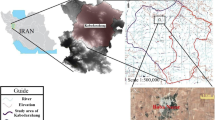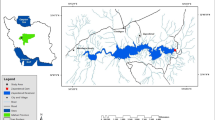Abstract
This chapter describes Artificial Neural Network optimization technique and Wavelet Support Vector Machine (WA-SVR) model for predicting the groundwater level in the given terrain. Ground water forecasting is significantly needed for groundwater management. The most important purpose of applying the neural network (artificial) was to extract the probability of various algorithms. Now-a-days, Artificial Neural Networks (ANN) are the most widely accepted modeling technique which can approximate the relationship (nonlinear) between input datasets and output results without considering physical processes and the corresponding equations of the system. Due to this capability, an ANN model is much faster than a physically based model which it approximates. Prediction of accurate groundwater head helps in the practical and best possible usage of the water resources. The performance of the models was evaluated by using two performance measures, the correlation coefficient (R) and Nash–Sutcliffe Efficiency Index (Ef). Model accuracy has been improved using different network architectures and training algorithms. After improving the model accuracy, it has been noticed that the best results can be accomplished with a typical feedforward neural network (FFNN) trained with the Levenberg–Marquardt (LM) algorithm obtained for simulation of ground water levels. The results revealed that ANN model technique was appropriate for predicting the groundwater heads. The study conclusively confirms the ability of ANNs to give the precise estimation of the head value with fair accuracy. From the results, it has been concluded that the ANNs have simulated and predicted the water heads in the river under acceptable residuals, whereas WA-SVR model’s results are more accurate. Study concludes that wavelet decomposition-based SVR is found superior in comparison of the ANN model.
Access this chapter
Tax calculation will be finalised at checkout
Purchases are for personal use only
Similar content being viewed by others
References
Ahmad, S., & Simonovic, S. P. (2005). An artificial neural network model for generating hydrograph from hydro-meteorological parameters. Journal of Hydrology, 315(1–4), 236–251.
Aitkenhead, M. J., & Cooper, R. J. (2008). Neural network time series prediction of environmental variables in a small upland headwater in NE Scotland. Hydrological Processes: An International Journal, 22(16), 3091–3101.
Anmala, J., Zhang, B., & Govindaraju, R. S. (2000). Comparison of ANNs and empirical approaches for predicting watershed runoff. Journal of Water Resources Planning and Management, 126(3), 156–166.
Cancelliere, A., Giuliano, G., Ancarani, A., & Rossi, G. (2002). A neural networks approach for deriving irrigation reservoir operating rules. Water Resources Management, 16(1), 71–88.
Cannon, A. J., & Whitfield, P. H. (2002). Downscaling recent streamflow conditions in British Columbia, Canada using ensemble neural network models. Journal of Hydrology, 259(1–4), 136–151.
Coulibaly, P., Anctil, F., Aravena, R., & Bobée, B. (2001). Artificial neural network modeling of water table depth fluctuations. Water Resources Research, 37(4), 885–896.
Cross, S. S., Harrison, R. F., & Kennedy, R. L. (1995). Introduction to neural networks. The Lancet, 346(8982), 1075–1079.
Daliakopoulos, I. N., Coulibaly, P., & Tsanis, I. K. (2005). Groundwater level forecasting using artificial neural networks. Journal of Hydrology, 309(1–4), 229–240.
Dogan, D., Isik, S., Toluk, T., & Sandalci, M. (2007). Daily streamflow forecasting using artificial neural networks. In International Congress on River Basin Management, River Basin Flood Management (Chap. IV, pp. 448–459).
Fletcher, R., & Reeves, C. M. (1964). Function minimization by conjugate gradients. Computer Journal, 7, 149–154.
Ghose, D. K., Panda, S. S., & Swain, P. C. (2010). Prediction of water table depth in western region, Orissa using BPNN and RBFN neural networks. Journal of Hydrology, 394(3-4), 296–304.
Hagan, M. T., & Menhaj, M. B. (1994). Training feedforward networks with the Marquardt algorithm. IEEE Transactions on Neural Networks, 5(6), 989–993.
Hagan, M. T., Demuth, H. B., & Beale, M. (1996). Neural network design, Thomson learning. Noida: Vikas Publishing House.
Hornik, K. (1991). Approximation capabilities of multilayer feedforward networks. Neural Networks, 4(2), 251–257.
Hornik, K., Stinchcombe, M., & White, H. (1989). Multilayer feedforward networks are universal approximators. Neural Networks, 2(5), 359–366.
Karmokar, B. C., Mahmud, M. P., Siddiquee, M. K., Nafi, K. W., & Kar, T. S. (2012). Touchless written English characters recognition using neural network. International Journal of Computer & Organization Trends, 2(3), 80–84.
Karunanithi, N., Grenney, W. J., Whitley, D., & Bovee, K. (1994). Neural networks for river flow prediction. Journal of Computing in Civil Engineering, 8(2), 201–220.
Kendall, M. G. (1938). A new measure of rank correlation. Biometrika, 30(1/2), 81–93.
Kumar, D. N., Raju, K. S., & Sathish, T. (2004). River flow forecasting using recurrent neural networks. Water Resources Management, 18(2), 143–161.
Moharir, K., Pande, C., & Patil, S. (2017). Inverse modeling of Aquifer parameters in basaltic rock with the help of pumping test method using MODFLOW software. Geoscience Frontiers, 8, 1385–1395.
Moller, H. (1993). A scaled conjugate gradient algorithm for fast supervised learning. Neural Networks, 6(4), 525–533.
Nash, J. E., & Sutcliffe, J. V. (1971). River flow forecasting through conceptual models. Part 1: A discussion of principles. Journal of Hydrology, 10(3), 282–290.
Omar, P. J., Gaur, S., Dwivedi, S. B., & Dikshit, P. K. S. (2019). Groundwater modelling using an analytic element method and finite difference method: an insight into lower ganga river basin. Journal of Earth System Science 128(7), 195
Omar, P. J., Gaur, S., Dwivedi, S. B., & Dikshit, P. K. S. (2020). A modular three-dimensional scenario-based numerical modelling of groundwater flow. Water Resources Management 34(6), 1913–1932.
Omar P.J., Gaur S., Dwivedi S.B., & Dikshit P.K.S. (2021) Development and Application of the Integrated GIS-MODFLOW Model. In: Gupta P.K., Bharagava R.N. (eds) Fate and Transport of Subsurface Pollutants. Microorganisms for Sustainability, vol 24. Springer, Singapore. https://doi.org/10.1007/978-981-15-6564-9_16
Peters, R., Schmitz, G., & Cullmann, J. (2006). Flood routing modelling with artificial neural networks. Advances in Geosciences, 9, 131–136.
Raman, H., & Sunilkumar, N. (1995). Multivariate modelling of water resources time series using artificial neural networks. Hydrological Sciences Journal, 40(2), 145–163.
Riedmiller, M., & Braun, H. (1993). A direct adaptive method for faster backpropagation learning: The RPROP algorithm. In IEEE International Conference on Neural Networks (pp. 586-591).
Sajikumar, N., & Thandaveswara, B. S. (1999). A non-linear rainfall–runoff model using an artificial neural network. Journal of Hydrology, 216(1–2), 32–55.
Shivhare, N., Rahul, A. K., Omar, P. J., Chauhan, M. S., Gaur, S., Dikshit, P. K. S., & Dwivedi, S. B. (2018). Identification of critical soil erosion prone areas and prioritization of micro-watersheds using geoinformatics techniques. Ecological engineering, 121, 26–34.
Sudheer, K. P., & Jain, A. (2004). Explaining the internal behaviour of artificial neural network river flow models. Hydrological Processes, 18(4), 833–844.
Thirumalaiah, K., & Deo, M. C. (1998). River stage forecasting using artificial neural networks. Journal of Hydrologic Engineering, 3(1), 26–32.
Author information
Authors and Affiliations
Editor information
Editors and Affiliations
Rights and permissions
Copyright information
© 2021 The Editor(s) (if applicable) and The Author(s), under exclusive license to Springer Nature Switzerland AG
About this chapter
Cite this chapter
Gaur, S., Johannet, A., Graillot, D., Omar, P.J. (2021). Modeling of Groundwater Level Using Artificial Neural Network Algorithm and WA-SVR Model. In: Pande, C.B., Moharir, K.N. (eds) Groundwater Resources Development and Planning in the Semi-Arid Region. Springer, Cham. https://doi.org/10.1007/978-3-030-68124-1_7
Download citation
DOI: https://doi.org/10.1007/978-3-030-68124-1_7
Published:
Publisher Name: Springer, Cham
Print ISBN: 978-3-030-68123-4
Online ISBN: 978-3-030-68124-1
eBook Packages: Earth and Environmental ScienceEarth and Environmental Science (R0)




